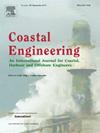多光谱卫星光学影像的沙洲提取光谱指数
IF 4.5
2区 工程技术
Q1 ENGINEERING, CIVIL
引用次数: 0
摘要
卫星图像允许对动态海岸过程进行大规模监测,海岸线跟踪是最广泛的应用。近岸波浪形成的沙洲作为天然缓冲带,通过波浪能量耗散和与空中海滩的沉积物交换减少海滩侵蚀,从而影响海岸动力学。尽管它们很重要,但在基于卫星的研究中往往被忽视。本文通过引入沙洲指数(SBI)来解决这一问题,这是一种新的方法,旨在优化由下伏沙洲引起的破波像素的检测,同时最大限度地减少来自周围环境(如沙子、土地和水)的SBI值像素。破波像素是指在光学卫星图像中,破波产生泡沫,增加反射率的图像像素。由于波浪破碎通常发生在淹没的沙洲上,因此这些像素可以作为它们检测的代理。通过将该指数集成到自动化处理框架中,可以在海岸线位置旁边生成沙洲位置的长期时间序列。为了验证我们的方法,Sentinel-2图像被用于比较卫星获得的沙洲位置与来自美国北卡罗莱纳州Duck地区野外研究设施(FRF)近十年的原位水深数据。验证结果显示了良好的一致性(STD = 23.2 m,即2个Sentinel-2像素),证明了该方法能够捕获陆上和海上沙洲的迁移。SBI的灵活性允许在不同的卫星平台上实施,包括陆地卫星和VENμS,证明了其可移植性。该应用程序为未来的研究奠定了基础,利用超过40年的历史卫星数据,进一步研究长期沙洲动力学,以及伴随卫星任务的重访和分辨率的增加的高频动力学。从卫星数据中整合多个可观察指标,可以将沿海系统作为一个动态实体进行更细致的表征。本文章由计算机程序翻译,如有差异,请以英文原文为准。
SBI: A sandbar extraction spectral index for multi-spectral satellite optical imagery
Satellite imagery allows for large-scale monitoring of dynamic coastal processes, with shoreline tracking being the most widespread application. Nearshore wave-generated sandbars influence coastal dynamics by acting as natural buffers that reduce beach erosion through wave energy dissipation and sediment exchange with the aerial beach. Despite their importance, they are often overlooked in satellite-based studies. This paper addresses this oversight by introducing the SandBar Index (SBI), a new methodology designed to optimize the detection of wave breaking pixels induced by the underlying sandbar while minimizing the SBI value pixels from the surrounding environment such as sand, land and water. Wave breaking pixels refer to image pixels where breaking waves generate foam, increasing reflectance in optical satellite imagery. Since wave breaking typically occurs over submerged sandbars, these pixels act as proxies for their detection. By integrating this index into an automated processing framework, long-term time series of sandbar positions are generated alongside shoreline positions. To validate our methodology, Sentinel-2 images are used to compare satellite-derived sandbar positions with in-situ bathymetric data from the Field Research Facility (FRF) in Duck, North Carolina (US), over a period of nearly ten years. Validation results show good agreement (STD 23.2 m - i.e. 2 Sentinel-2 pixels), demonstrating the ability of the method to capture the onshore and offshore migration of sandbars. The flexibility of the SBI allows implementation on different satellite platforms, including Landsat and VENS, demonstrating its transferability. This application lays the groundwork for future studies using over 40 years of historical satellite data to further investigate long-term sandbar dynamics, but also high-frequency dynamics with the concomitantly increasing revisit and resolution of satellite missions. The integration of multiple observable metrics from satellite data allows for a more nuanced characterization of the coastal system as a dynamic entity.
求助全文
通过发布文献求助,成功后即可免费获取论文全文。
去求助
来源期刊

Coastal Engineering
工程技术-工程:大洋
CiteScore
9.20
自引率
13.60%
发文量
0
审稿时长
3.5 months
期刊介绍:
Coastal Engineering is an international medium for coastal engineers and scientists. Combining practical applications with modern technological and scientific approaches, such as mathematical and numerical modelling, laboratory and field observations and experiments, it publishes fundamental studies as well as case studies on the following aspects of coastal, harbour and offshore engineering: waves, currents and sediment transport; coastal, estuarine and offshore morphology; technical and functional design of coastal and harbour structures; morphological and environmental impact of coastal, harbour and offshore structures.
 求助内容:
求助内容: 应助结果提醒方式:
应助结果提醒方式:


